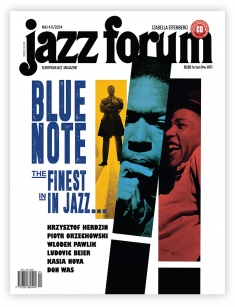JAZZ ZA ŻELAZNĄ KURTYNĄ
JF
„Jazz Behind the Iron Curtain” to tytuł książki prezentującej najciekawsze prace przedstawione we wrześniu 2008 roku na międzynarodowej konferencji
w Warszawie, w ramach projektu badawczego Freie Universität Berlin „Jazz w krajach byłego Bloku Wschodniego”.
Książka, pod redakcją prof. Gertrud Pickhan i Rüdigera Rittera, wydana została w Niemczech nakładem wydawnictwa Peter Lang w języku angielskim. W gronie ponad 20 autorów są m.in. ówcześni słuchacze Freie Universität Berlin Piotr Baron („Rozwój stylów narodowych w jazzie po II wojnie światowej na przykładzie jazzu polskiego”),
Igor Pietraszewski („Być muzykiem jazzowym w Polsce”) i Marta Domurat („Prasa jazzowa w PRL – Rola ‘Jazzu’ i ‘Jazz Forum’ w przeszłości i dzisiaj”).
Na okładce fotografia autorstwa Marka Karewicza (Modern Dixielanders na tyłach warszawskiego klubu Hybrydy, 1959). W sumie 320 str., twarda oprawa.
W błyskotliwym podsumowaniu na końcu tego zbioru wybitny krytyk niemiecki Bert Noglik konkluduje odnosząc się do pracy Marty Domurat o historii i funkcji „Jazz Forum”:
„Magazyn ten, w okresie swojego apogeum wydawany w trzech edycjach – polskiej, angielskiej i niemieckiej – krążył po wszystkich komunistycznych krajach Europy Wschodniej. Działając w maleńkim biurze w Warszawie przy ul. Nowogrodzkiej awansował do roli głównej kwatery międzynarodowej wymiany jazzowej.
Ale Jazz Forum nie tylko rozprzestrzeniał informacje o jazzie. Dysponując międzynarodową siatką korespondentów i organizując doroczne spotkania podczas warszawskich festiwali Jazz Jamboree, magazyn ten funkcjonował jako półoficjalna baza niezależna od państwowych ministerstw kultury, wywierając wpływ na te ośrodki w kilku krajach Wschodniej Europy. Magazyn Jazz Forum, a także Europejska Federacja Jazzowa, przemianowana później na Międzynarodowa Federację Jazzową spełniały pionierska rolę w ‘networking’ dużo wcześniej zanim ten termin stał się modny. W swojej małej cząstce przyczyniły się do ostatecznego upadku Wschodniego Bloku i zburzenia Żelaznej Kurtyny. Dla takich ludzi, jak Paweł Brodowski, redaktor naczelny magazynu, który wciąż wychodzi w polskojęzycznej edycji, musi wydawać się dziwne, że działalność wciąż jeszcze w pamięci świeża stała się już przedmiotem badań naukowych młodych naukowców. Dziwny jest ten świat.”
Informacja wydawcy:
Book synopsis
Jazz has never been simply music. From its very inception, jazz has been imbued with social meaning. This is what makes this kind of music an interesting field of study not only for the music historian, but also for the sociologist and the cultural historian. In the state socialist countries of East–Central Europe after World War II, jazz acquired a special meaning as a symbol of the American way of life, a symbol of freedom – at least for its admirers. The ruling elites and the establishment regarded jazz as music of the class enemy, a music of social degeneration. These contrasting views on jazz led to hot debates over jazz and the implementation of complicated policies towards jazz music and the jazz scene, which oscillated between affirmation and repression.
Contents
Contents: Gertrud Pickhan/Rüdiger Ritter: Introduction – Josef Jarab: Marching Regimes and Syncopating Drummers. The Stories of Jazz in Unfree Societies - John Gennari: The Other Side of the Curtain: U.S. Jazz Discourse, 1950s America, and the Cold War – Rüdiger Ritter: The Radio – a Jazz Instrument of its Own – Claire Levy: East and West in Dialogue. On the Intercultural Aspects of Jazz History – Yvetta Kajanová: Denotative Components of Jazz during the Period of Communism as Exemplified in Czech and Slovak Jazz – Martin Lücke: The Postwar Campaign against Jazz in the USSR (1945–1953) – Michael Abeßer: Between Cultural Opening, Nostalgia and Isolation – Soviet Debates on
Jazz between 1953 and 1964 – Marta Domurat: The Jazz Press in the People’s Republic of Poland. The Role of Jazz and Jazz Forum in the Past and Today – Piotr Baron: Development of «National styles» in Jazz after World War II. The Example of Polish Jazz – Igor Pietraszewski: Being a Jazz Musician in Poland – Tiit Lauk: Estonian Jazz Before and Behind the «Iron Curtain» – Heli Reimann: Lembit Saarsalu: «Music Saved Me.» The Study of a Jazz Musician's Early Musical Development – Ruth Leiserowitz: Jazz in Soviet Lithuania – a Nonconformist Niche – Gergö Havadi: An Individual Subculture Reflected in Domestic Spies' Reports. Hungarian Jazz in the Socialist Period – Adrian Popan: Jazz Revival in Romania 1964 -1971 – Peter Motycka: The Jazz Section – A Platform of Freedom in Czechoslovakia – Christian Schmidt-Rost: Freedom Within Limitations – Getting Access to Jazz in the GDR and PRP between 1945 and 1961 – Marina Dmitrieva: Jazz and Dress. Stiliagi in Soviet Russia and Beyond – Wiebke Janssen: «Don’t knock the Rock!» «Halbstarke» in both German states during the 1950s – Karl Brown: Dance Hall Days. Jazz and Hooliganism in Communist Hungary, 1948-1956 – Michael Dörfel: Poetry and Jazz: The Records of «Jazz Meets Literature» in the GDR – Bert Noglik: «Jazz behind the Iron Curtain» – a Conference in Warsaw.
About the author(s)/editor(s)
Gertrud Pickhan is Professor of East-Central European History at the Institute for East European Studies at Freie Universität Berlin.
Rüdiger Ritter has graduated in History of East and East Central Europe and Musicology. Both conduct a research project at Freie Universität Berlin on Jazz under State Socialism.
















